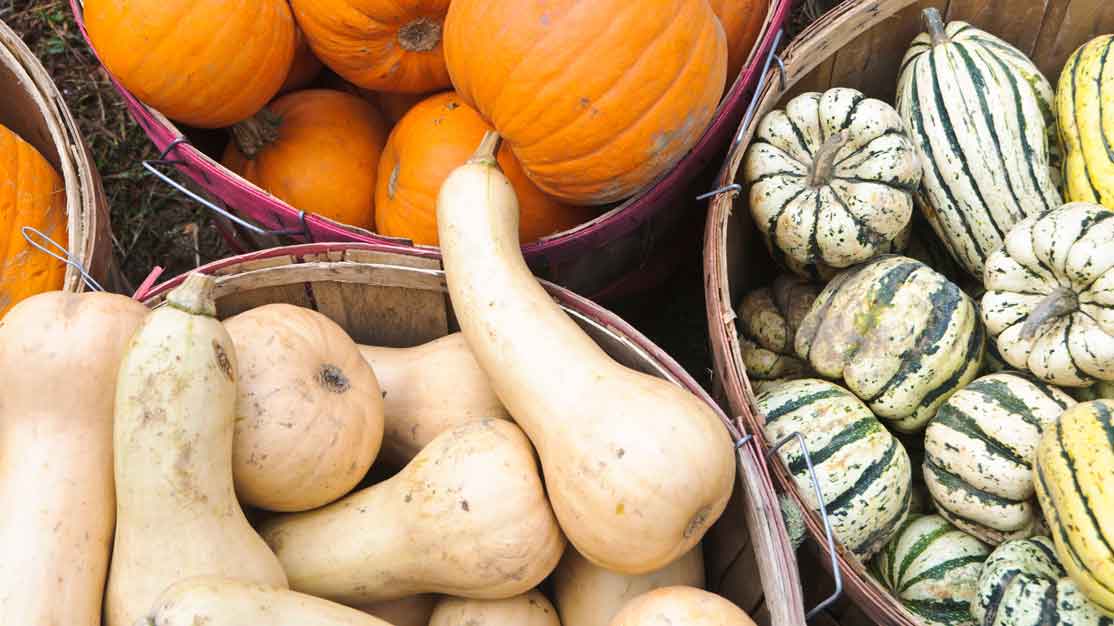Superfoods for the Fall
Updated by Jenilee Matz, MPH

Along with cooler temperatures and colorful leaves, autumn months bring a variety of nutritious foods into season.
Seasonal produce is picked at its prime-so it's not only exceptionally healthy, but flavor-rich.
Also known as functional foods, superfoods are associated with a potential range of benefits, such as guarding against disease. While there's no set criteria that make a food superior, emphasizing particularly nutritious foods in a balanced diet this fall-or any time-could go a long way toward boosting your wellness.
Pick Seasonal Fall Fruits
Apples, pears and cranberries are all in season during fall months. They also provide nutritious ways to feed your sweet tooth on holidays and in between. Apples and pears are good sources of fiber, which promotes appetite control and digestive wellness. Cranberries are loaded with antioxidants, which may enhance immune function.
For a simple sweet treat, bake pear and apple slices, dusted with cinnamon, until slightly soft. Add cooked or dried cranberries to salads and brown rice pilaf for more color and flavor. Mix dried cranberries with nuts and seeds for a healthy trail mix.
Cook Up Cruciferous Veggies
Cool fall months are a great time to cook broccoli, cauliflower and Brussels sprouts, and cooking enriches the flavor. As members of the cruciferous family, these autumn-ready veggies may help lower your risk for types of cancer.
Steam all three, cooking them al dente—slightly soft, but not mushy—for a nutritious addition to any meal. Mashed steamed cauliflower works well as a lighter, healthier alternative to mashed potatoes. Add a touch of olive oil and salt and pepper to taste. Roast Brussels sprouts in the oven, tossed with parmesan cheese and Italian seasoning. For a sweeter flare, add dried fruit.
Switch Up Your Salad
Even if you're not quite sure what Swiss chard and endive are, you've likely had them. Both leafy vegetables are commonly found in mixed greens. Bright green or yellow-green endive is a rich source of fiber. Swiss chard, which may be green, red or rainbow-colored, is high in vitamins A and C. Toss them with other veggies for a vibrant fall salad. For a warmer dish, sauté Swiss chard with olive oil, onions and garlic, which is also in season during the fall.
Fill Up on Fibrous Winter Squash
Sweet potatoes and squash, including pumpkins and butternut squash, are nutritious and filling fall picks. Also known as winter squash, these vegetables provide valuable amounts of antioxidants and fiber. Roasted or baked, their natural sweetness makes them a nutritious substitute for sugary sweets, and a satisfying side dish. For a healthy alternative to French fries, brush sliced sweet potatoes with olive oil and bake until crisp.
Putting it Together
No matter what the season, eating a balanced diet based on whole foods is important. While you're incorporating these superfoods into your diet this fall, remember to eat other healthy nutrient-dense foods as well. Choose lean protein sources, such as fish, boneless, skinless chicken breasts and legumes, and nutritious fat sources such as nuts, seeds and olive oil.
Updated on July 19, 2019
Sources:
"Functional foods: Explore the new but rely on the tried and true." Today's Dietitian. Web. 20 June 2019. https://www.todaysdietitian.com/newarchives/092208p42.shtml
"10 reasons to support farmer's markets," Center for Urban Education About Sustainable Agriculture. Web. 20 June 2019. https://cuesa.org/learn/10-reasons-support-farmers-markets
"What's in season? Fall," Produce for Better Health Foundation. Web. 20 June 2019. https://fruitsandveggies.org/stories/whats-in-season-fall/
"The beginner's guide to cruciferous vegetables," Academy of Nutrition and Dietetics. Web. 20 June 2019. https://www.eatright.org/food/vitamins-and-supplements/nutrient-rich-foods/the-beginners-guide-to-cruciferous-vegetables
"Antioxidants: In depth," National Center for Complementary and Integrative Health. Web. 20 June 2019. https://nccih.nih.gov/health/antioxidants/introduction.htm
"Cranberry," National Center for Complementary and Integrative Health. Web. 20 June 2019. https://nccih.nih.gov/health/cranberry